| IC 443 - The Jellyfish Nebula This nebula is most probably what is left of a supernova that occurred about 30,000 to 50,000 years ago. At its center is a neutron star that was formed when the stellar core collapsed. The Jellyfish Nebula is in the constellation Gemini (The Twins), and is about 5,000 light-years from Earth. Image processed by Ron Yelton, original data from Telescope Live |
The Horsehead and Flame Nebulae
(Barnard 33 and NGC 2024) This wide-field view contains both the Horsehead and Flame Nebulae. It shows a very small portion of the great Orion Molecular Cloud complex, which stretches from above Orion's head (Betelgeuse) to below his feet (Rigel). it was imaged in the HSO pallette. They both lie about 1375 light-years away. the Horsehead is a dark nebula while the Flame nebula is an emission nebula. Image processed by Ron Yelton, original data from Telescope Live |
Wide-field view of the region
around Deneb Deneb is a very bright star in the constellation Cygnus - The Swan, and represents its tail. Another notable star in Cygnus is Alberio, a colorful double star systen that is the head of the swan. Cygnus is also sometimes referred to as the Northern Cross. It is also part of an asterism known as the Summer Triangle, which is made up of Deneb, Altair and Vega. Its mass is about 20-25 solar masses which means that it will end up as a supernova. It is about 2600 light-years away. Image processed by Ron Yelton, original data from Telescope Live |
|
Location: IC Astronomy Observatory, Spain
Date: December 2023 Mount: Paramount MX+ Telescope: Takahashi FSQ-106ED (SPA-1) Camera: QHY600m CMOS @ -25c Exposure: SHO 49 x5 min Total: 4 hrs 5 min |
Location: IC Astronomy Observatory, Spain
Date: January 2024 Mount: Paramount MX+ Telescope: Takahashi FSQ-106ED (SPA-1) Camera: QHY600m CMOS @ -25c Exposure: SHO 189 x 5 min (HSO) Total: 13 hrs 15 min |
Location: IC Astronomy Observatory, Spain
Date: January 2024 Mount: Paramount MX+ Telescope: Takahashi FSQ-106ED (SPA-1) Camera: QHY600m CMOS @ -25c Exposure: SHO 63 x 5 min (HSO) Total: 5 hrs 15 min |
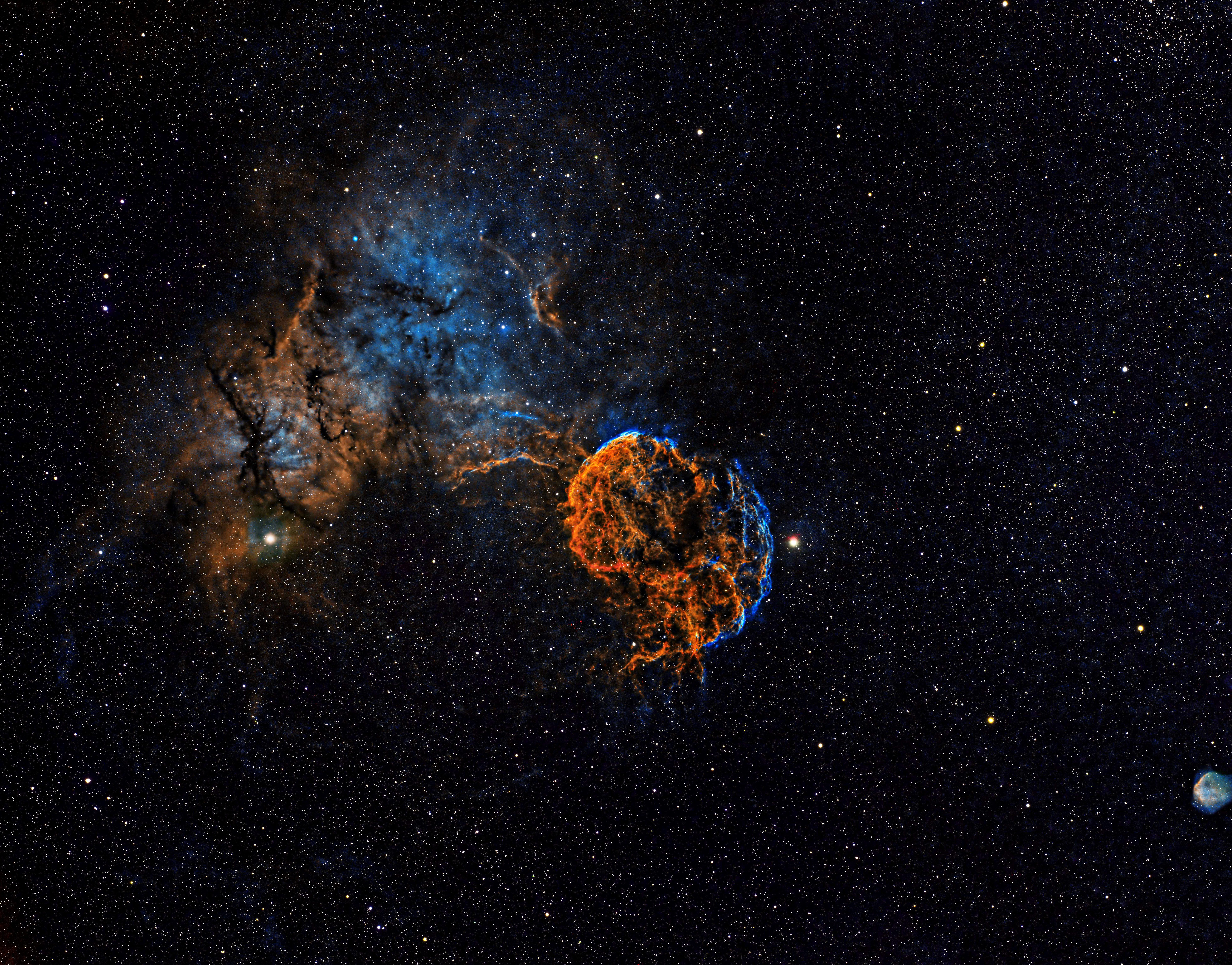 |
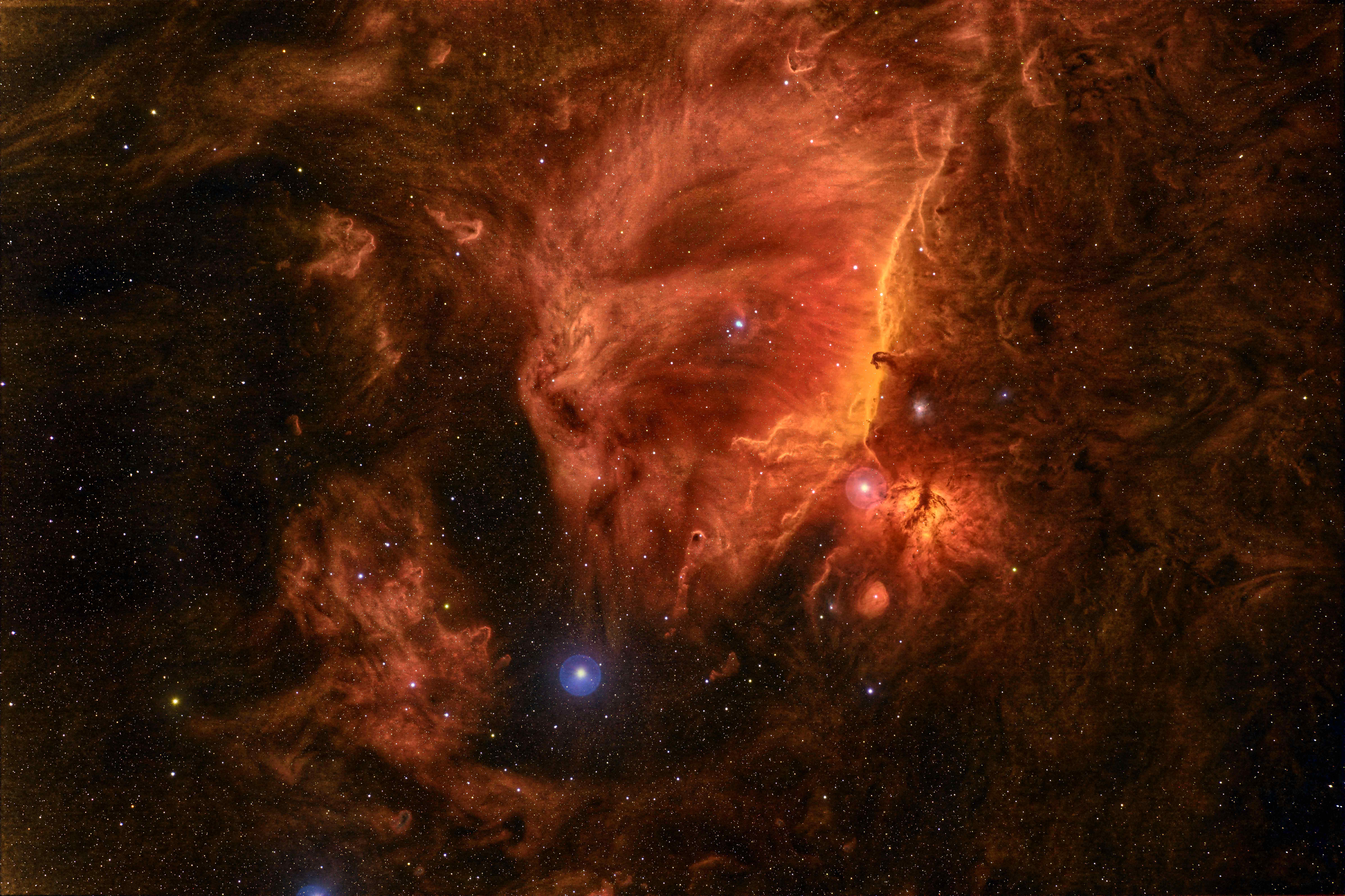 |
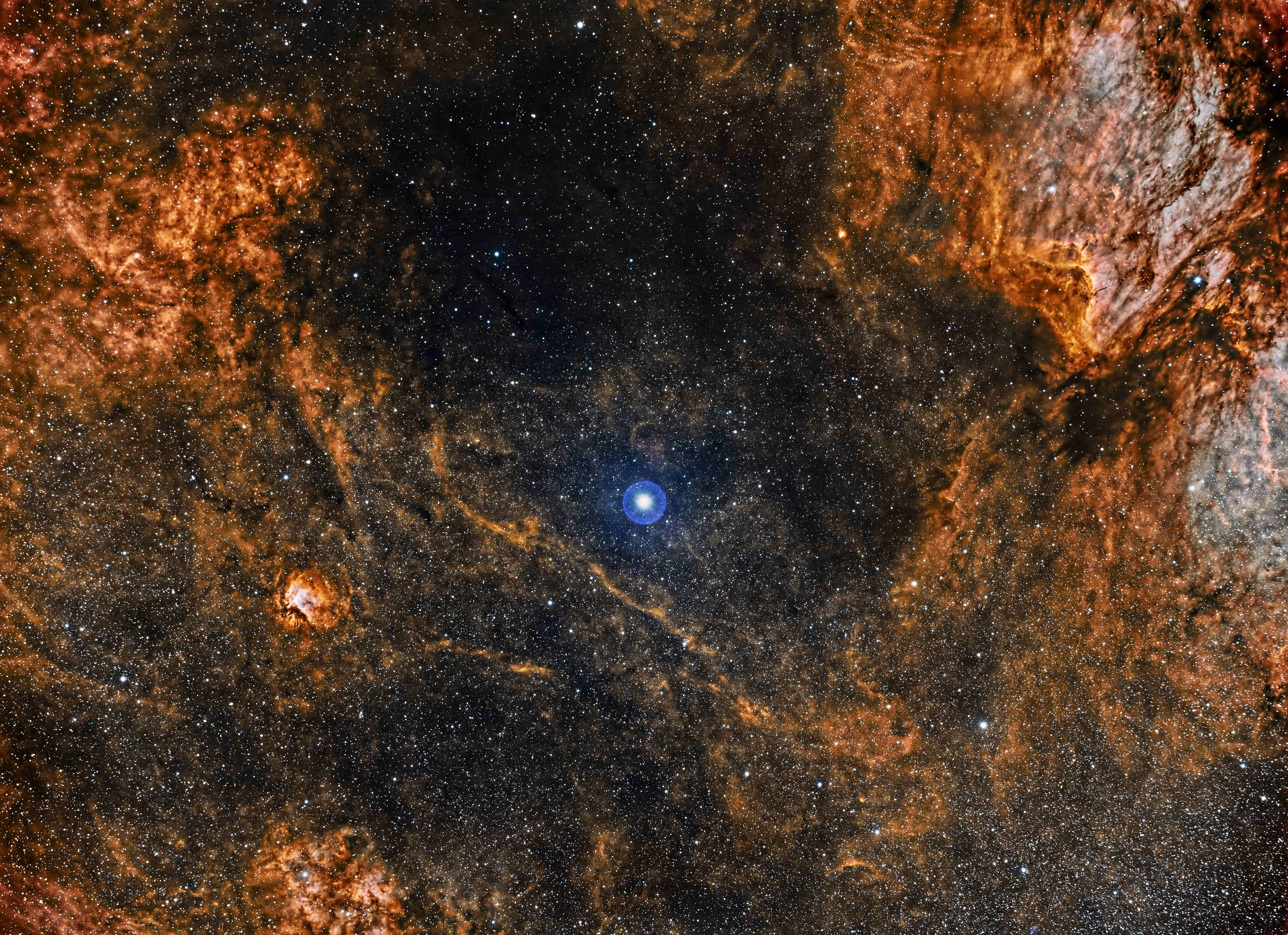 |
| LDN 1235 - The Shark Nebula The Shark Nebula resides in the constellation of Cepheus. Cepheus was the king of Aethiopia. He was married to Cassiopeia and was the father of Andromeda. This nebula is classified as both a dark nebula as well as a reflection nebula. There are two reflection nebulae - one just behind its head and the other at the base of its neck. Dark nebulae are very, very faint and can only be seen in long exposure images. Image processed by Ron Yelton, original data from Telescope Live |
IC 2177 - The Seagull Nebula This nebula lies right on the border of the constellation Canis Major (the Big Dog) and Monoceros (the Unicorn). It is an emission nebula. I processed this image in the HSO palette (Hydrogen alpha assigned to the red channel, sulphur to the green channel and oxygen to the blue channel. See the image to the right for another version of the same object. Image processed by Ron Yelton, original data from Telescope Live |
IC 2177 - The Seagull Nebula Here is a another version of the Seagull Nebula. This one was processed in the OHS palette (Oxygen assigned to the red channel, hydrogen alpha to the green channel and sulphur to the blue channel). There are 24 different possible combinations to choose from. Most of which come out in some really bizzare colors. The fun part for me is that different details emerge with every color combination. Image processed by Ron Yelton, original data from Telescope Live |
|
Location: IC Astronomy Observatory, Spain
Date: December 2023 Mount: Paramount MX+ Telescope: Takahashi FSQ-106ED (SPA-1) Camera: QHY600m CMOS @ -25c Exposure: 27 x 5 min (RGB) Total: 2 hrs 15 min |
Location: IC Astronomy Observatory, Spain
Date: December 2023 Mount: Paramount MX+ Telescope: Takahashi FSQ-106ED (SPA-1) Camera: QHY600m CMOS @ -25c Exposure: 76 x 5 min (HSO) Total: 6 hrs 20 min |
Location: IC Astronomy Observatory, Spain
Date: December 2023 Mount: Paramount MX+ Telescope: Takahashi FSQ-106ED (SPA-1) Camera: QHY600m CMOS @ -25c Exposure: 76 x 5 min (HSO) Total: 6 hrs 20 min |
 |
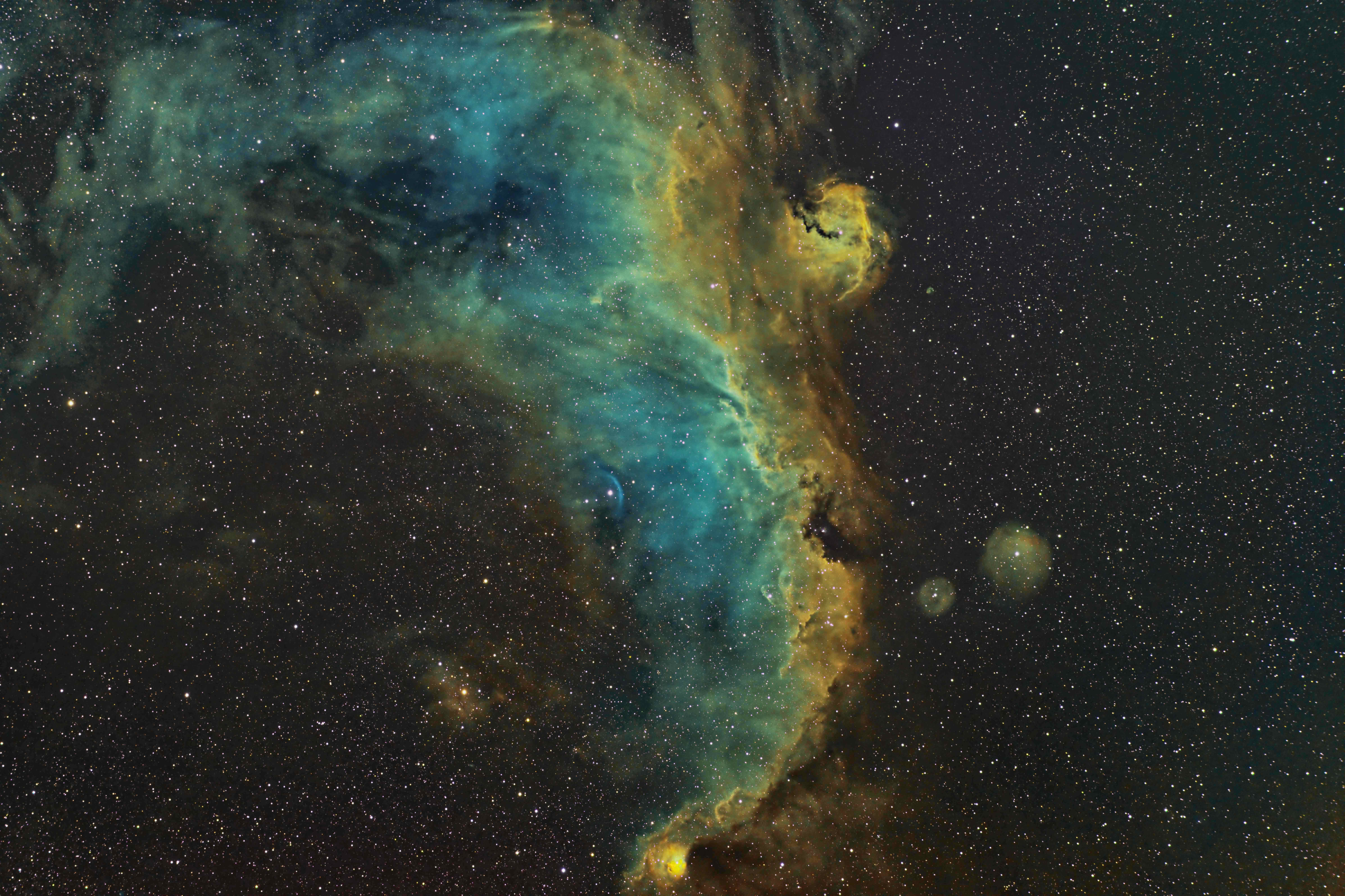 |
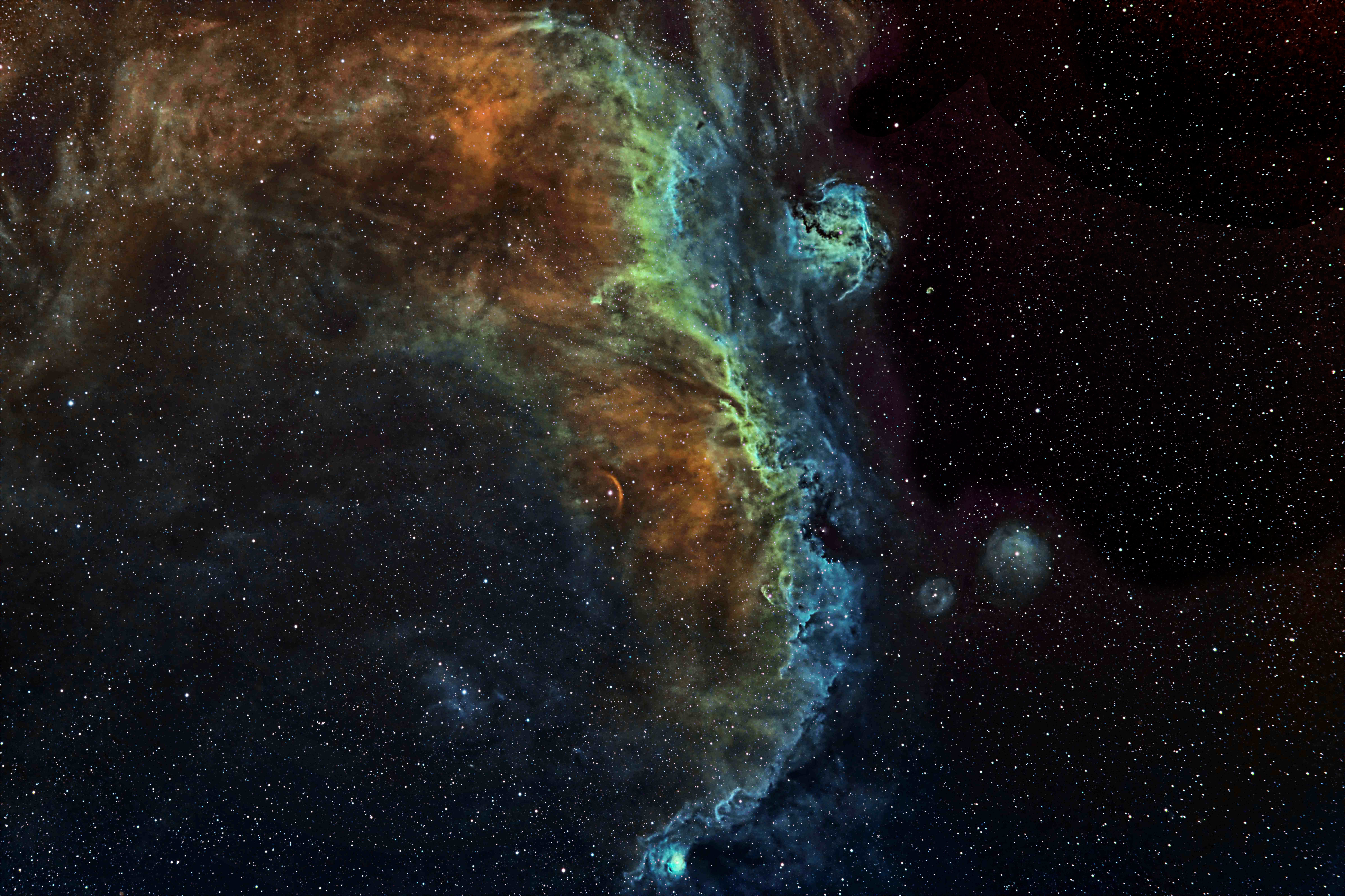 |
RCW 32
| NGC 2626 NGC 2626 is in the constellation Vela. Vela refers to the sail of Jason's ship, the Argo Navis, that Jason and the Argonauts sailed in to retrieve the Golden Fleece. There is certainly a lot going on in this nebula, which is a reflection, emission and absorption nebula. It has a a pulsar in its midst that is the brightest celestial source of gamma rays. It lies about 3300 light-years away. Image processed by Ron Yelton, original data from Telescope Live |
CG4 - God's Hand Known as God's Hand, this nebula is located about 1300 light-years from Earth in the constellation Puppis. Image processed by Ron Yelton, original data from Telescope Live |
RCW 32 Just about 3000 light-years from us, in the constellation Vela is this interesting nebula. It is an emission nebula that is part of a larger HII regon. Image processed by Ron Yelton, original data from Telescope Live |
|
Location: El
Sauce Observatory, Chile
Date: March 2023 Mount: Mathis MI-1000/1250 Telescope: Planewave CDK24 (CHI-1) Camera: QHY600m @-25c Exposure: 67 x 5 min for LRGB. Total: 5 hrs 35 min |
Location: El
Sauce Observatory, Chile
Date: November - December 2022 Mount: Mathis MI-1000/1250 Telescope: Planewave CDK24 (CHI-1) Camera: FLI PL9000 @ -25c Exposure: 80 x 10 min for HRGB. Total: 13 hrs 20 min |
Location: El Sauce
Observatory, Chile
Date: November - December 2022 Mount: Mathis MI-1000/1250 Telescope: Planewave CDK24 (CHI-1) Camera: QHY600m @-25c Exposure: 67 x 5 min for HRGB. Total: 5 hrs 35 min |
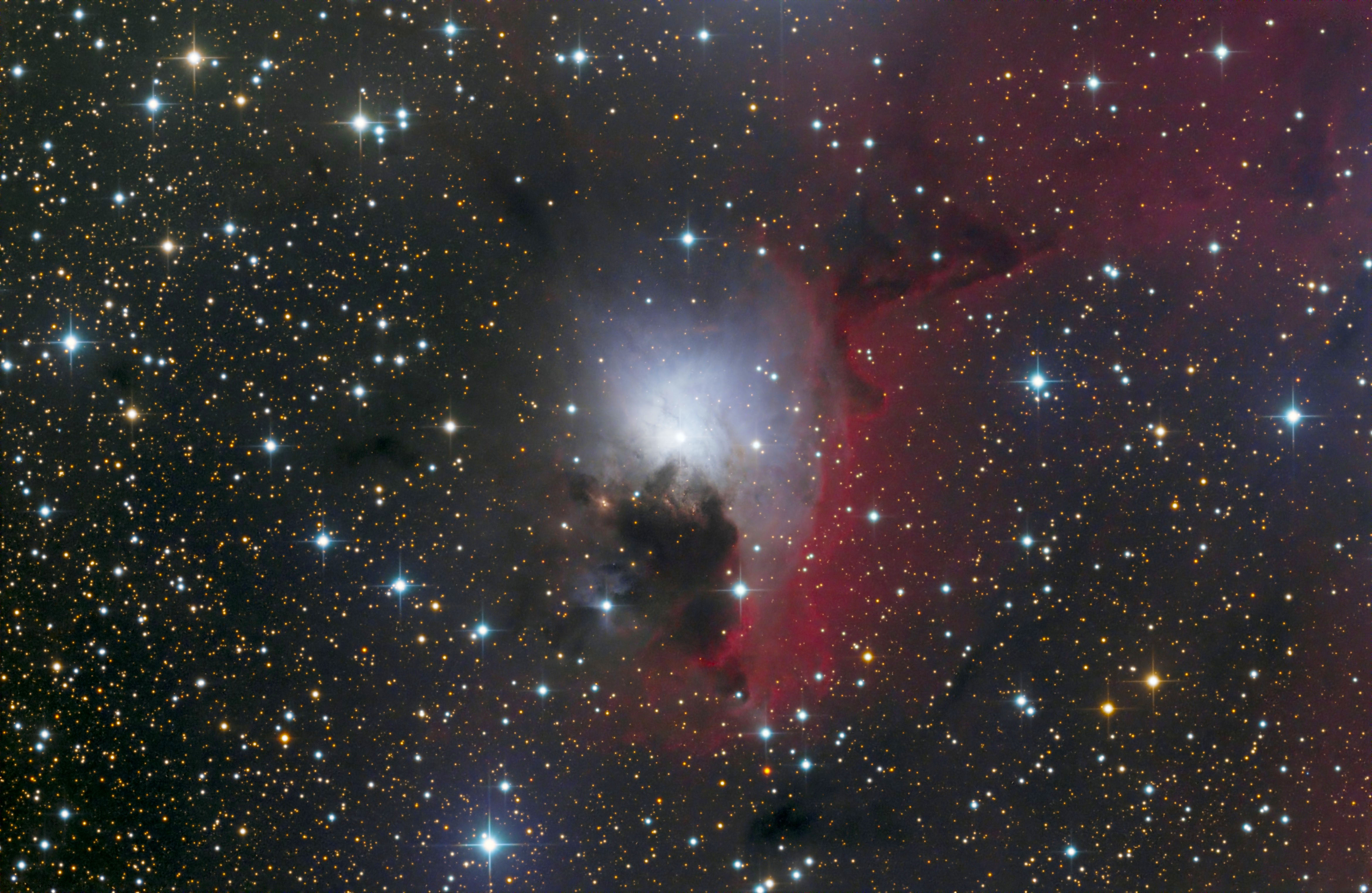 |
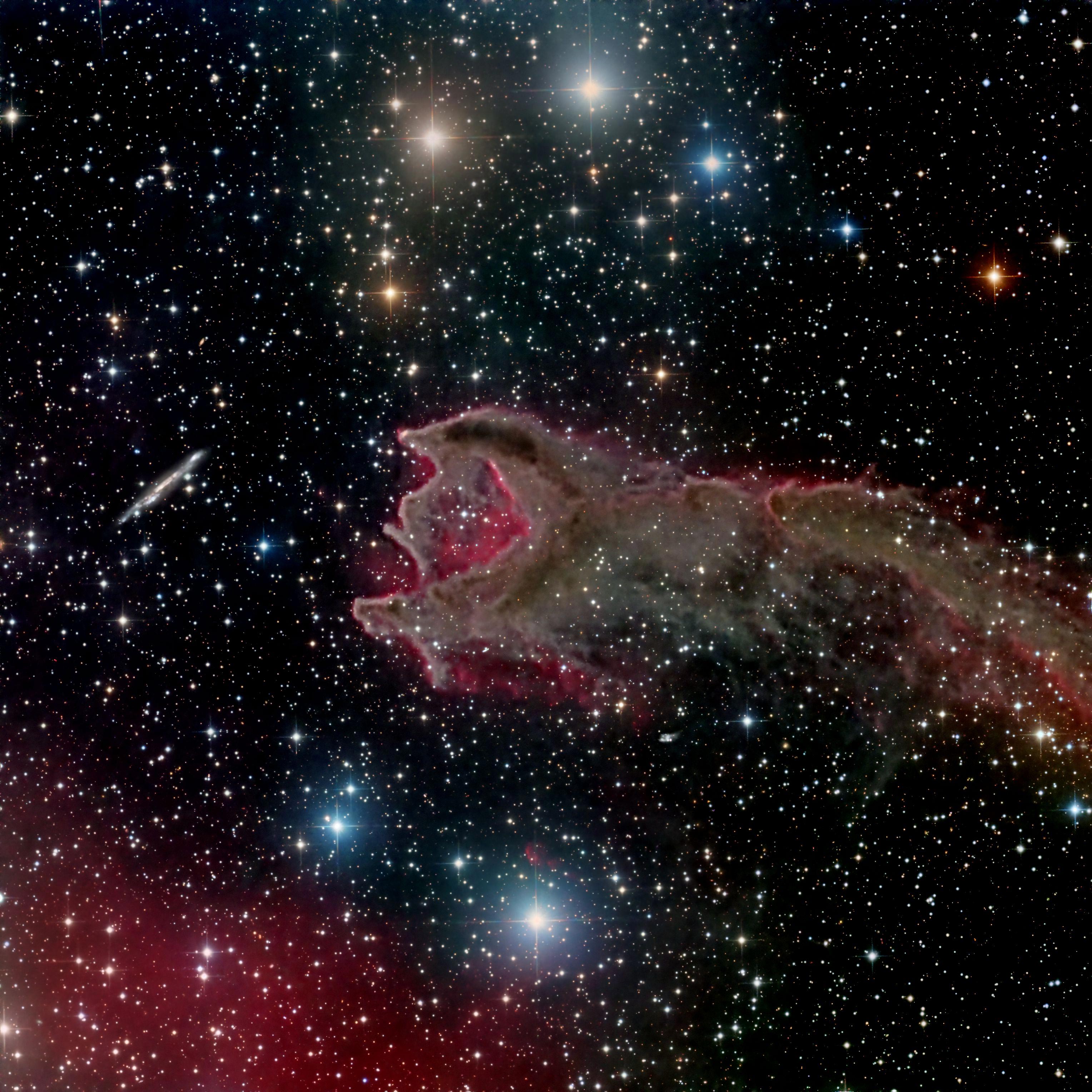 |
 |
| RCW 6
(Sh2-301) Out in Canis Major (the Big Dog - one of two that were Orion's hunting dogs), is RCW 6. It is a Hydrogen II region that is about 19,000 light-years away from us. Image processed by Ron Yelton, original data from Telescope Live |
NGC 2264
This nebula is in the constellation Monoceros. It lies about 2700 light-years away from us. NGC 2264 actually refers to two objects The Cone Nebula and the Christmas Tree Nebula. Also within this huge reflection nebula are the Fox Fur and Snowflake Nebulae. This a re-do of the same image on the Nebulae 3 page. I did a real-time processing of this object as a presentation for our local astronomy club in April 2024. I processed it at least once a day for a month in order to recreate the first version. Never could duplicate that first effort, but this one turned out just as nice. Image processed by Ron Yelton, original data from Telescope Live |
Messier 16 -
The Eagle
Nebula (Pillars of Creation) The Eagle Nebula is part of a huge diffuse emission nebula located in the constellation Serpens (The Snake). It was made famous with an image by the Hubble Space Telescope which dubbed it the Pillars of Creation. It contains several regions of star-forming gas and dust. This version is done in the Hubble Palette (SHO). Thus the strange colors. Image processed by Ron Yelton, original data from Telescope Live |
|
Location: El
Sauce Observatory, Chile
Date: December 2023 Mount: Mathis MI-1000 Telescope: Planewave CDK24 f/6.6 Camera: QHY600m CMOS @-25c (CHI-1) Exposure: 100 x 5 min each for LRGB. Total: 7 hrs 50 min |
Location: El
Sauce Observatory, Chile
Date: December 2023 Mount: Mathis MI-1000 Telescope: Planewave CDK24 f/6.6 Camera: QHY600m CMOS @-25c (CHI-1) Exposure: 63 x 5 min each for LRGB. Total: 5 hrs 15 min |
Location: El
Sauce Observatory, Chile
Date: Jun 10, 2023 Mount: Mathis MI-1000 Telescope: Planewave CDK24 f/6.6 Camera: QHY600m CMOS @-25c (CHI-1) Exposure: 63 x 5 min each for LRGB. Total: 5 hrs 15 min |
 |
 |
 |
| RCW 61 -
(Head of the Running Chicken Nebula) Down in the southern constellation of Centaurus (The Centaur), lies an absolutely huge nebula called the Running Chicken Nebula, officially named the Lambda Centauri Nebula. It is roughly 7,300 light-years away from us. This portion of the nebula is the head of the Running Chicken. You can find my rendition of the Running Chick on the "Images with Telescope Live - Page 1." Image processed by Ron Yelton, original data from Telescope Live |
RCW
52 This nebula is in the Carina Nebula. Carina is the Latin word for keel of a ship. RCW 52 lies about 5200 light-years away and is about 70 light-years in diameter. Image processed by Ron Yelton, original data from Telescope Live |
IC 2169 This is a reflection nebula in Monoceros (the Unicorn). Image processed by Ron Yelton, original data from Telescope Live |
|
Location: El
Sauce Observatory, Chile
Date: March-April 2024 Mount: Mathis MI-1000 Telescope: Planewave CDK24 f/6.6 Camera: QHY600m CMOS @-25c (CHI-1) Exposure: 63 x 10 min each for OSH. Total: 10 hrs 30 min |
Location: El
Sauce Observatory, Chile
Date: March 2024 Mount: Mathis MI-1000 Telescope: Planewave CDK24 f/6.6 Camera: QHY600m CMOS @-25c (CHI-1) Exposure: 137 x 5 min each for OSH. Total: 10 hrs 55 min |
Location: El
Sauce Observatory, Chile
Date:April 5, 2024 Mount: Mathis MI-1000 Telescope: Planewave CDK24 f/6.6 Camera: QHY600m CMOS @-25c (CHI-1) Exposure: 48 x 5 min each for LRGB Total: 4 hrs |
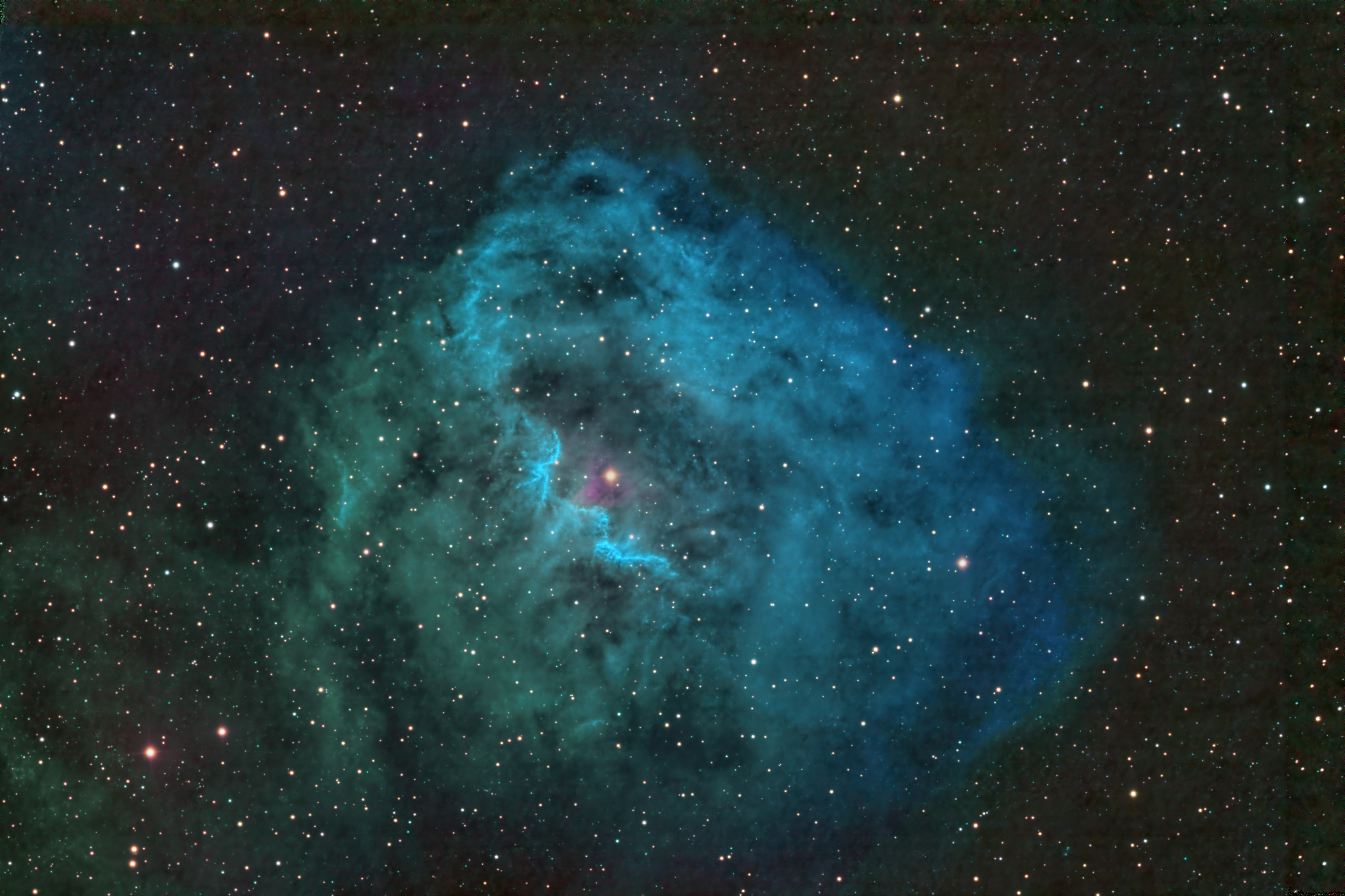 |
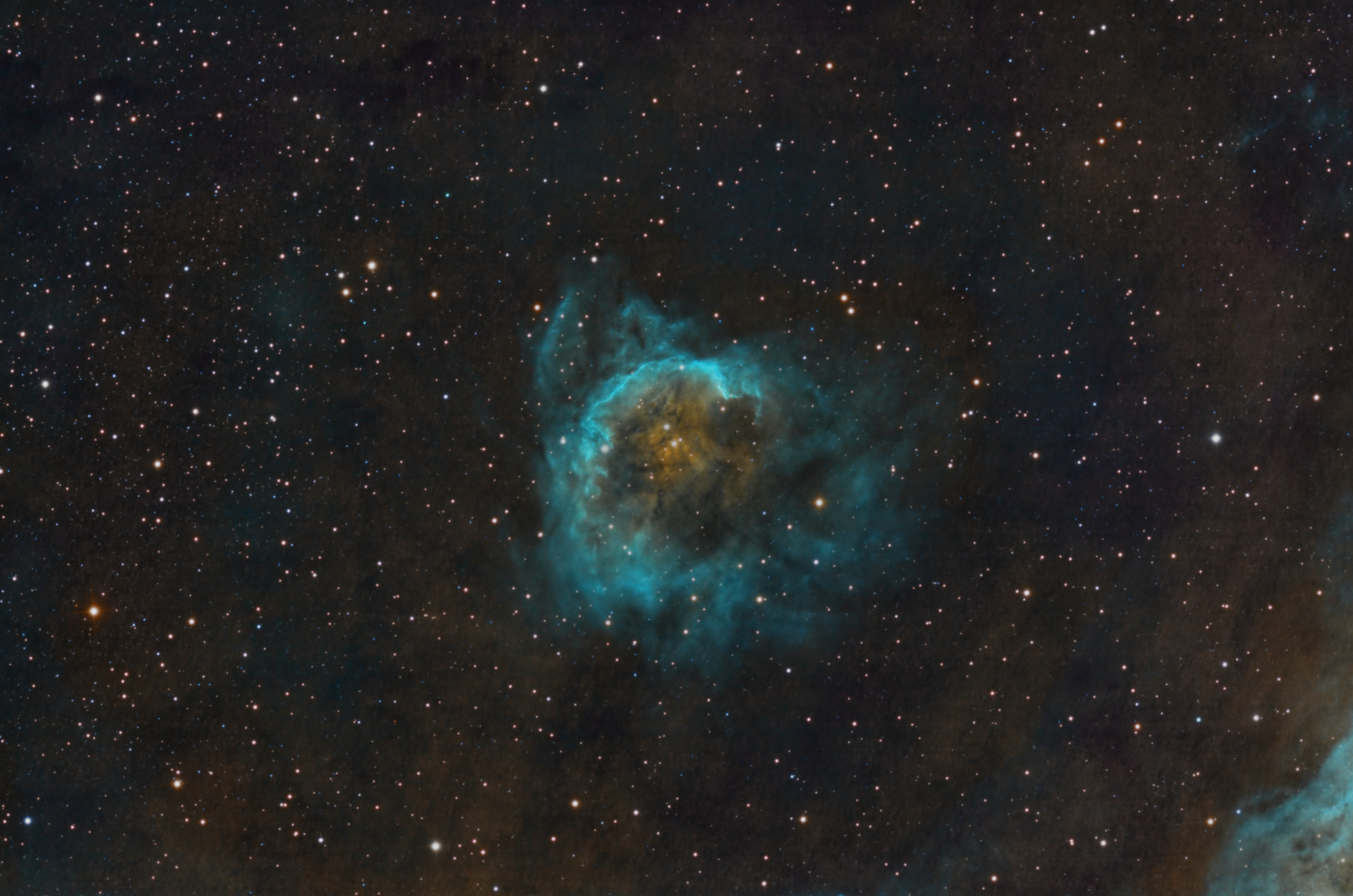 |
 |
| Messier
8 - The Rosette Nebula The Rosette Nebula is a HII region in Monoceros (the Unicorn) and lies about 5200 light-years away. It is 65 light-years in diameter which is about half the diameter of our own Milky Way galaxy. The stars in the center are an open cluster (NGC) 2237) which is made up of 36 new stars. If you zoom deep into this image and scroll through it you'll find at least an additional 45 galaxies. This image was processed in the Hubble Palette OHS. Image processed by Ron Yelton, original data from Telescope Live |
Messier 8 - The
Rosette Nebula
This is another version of the Rosette Nebula that was process using the Hubble Palette SHO. Image processed by Ron Yelton, original data from Telescope Live |
The Dark Doodad
Nebula This another view of an image on the Nebula-2 page. This one used a larger telescope which gives us a more zoomed-in view. This dark nebula is commonly known as the Doodad Nebula. It's a long, cold molecular cloud in the constellation Musca (The Fly). This one almost looks like a shark standing on its tail.. Image processed by Ron Yelton, original data from Telescope Live |
|
Location:
Heaven's Mirror Observatory,
Australia
Date: March 2024 Mount: Paramount MX+ Telescope: FSQ-106ED (AUS-2) Camera: QHY600m @ -25c Exposure: 97 x 5 min each for OHS Total: 4hrs 35 min |
Location:
Heaven's Mirror Observatory,
Australia
Date: March 2024 Mount: Paramount MX+ Telescope: FSQ-106ED (AUS-2) Camera: QHY600m @ -25c Exposure: 97 x 5 min each for SHO Total: 4hrs 35 min |
Location: El
Sauce Observatory, Chile
Date: March 16, 2021 Mount: Mathis MI-1000 Telescope: Planewave CDK24 f/6.6 Camera: FLI ProLine PL9000 @-25c (CCD)(CHI-1) Exposure: 63 x 10 min each for LRGB. Total: 10 hrs 30 min |
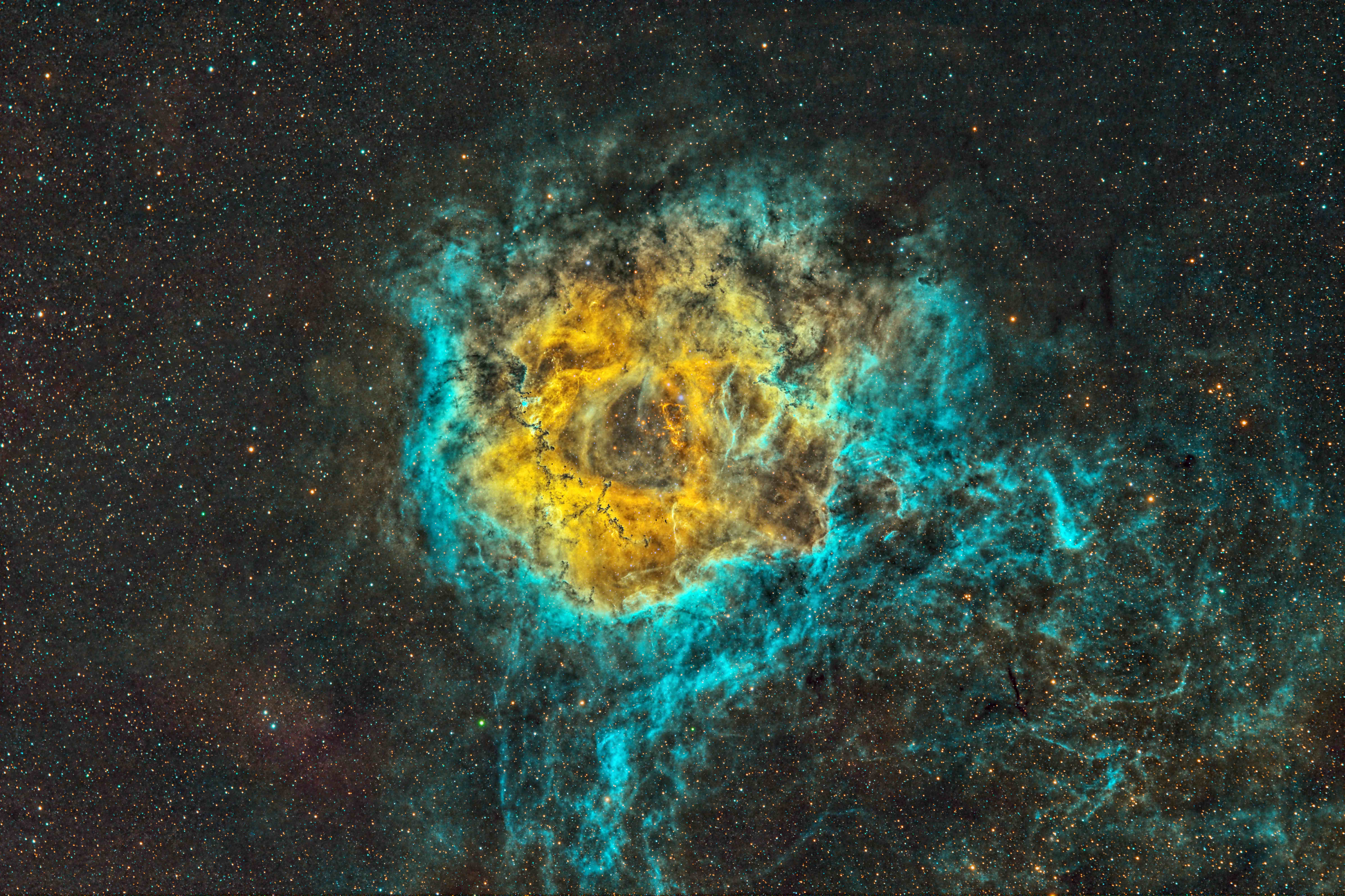 |
 |
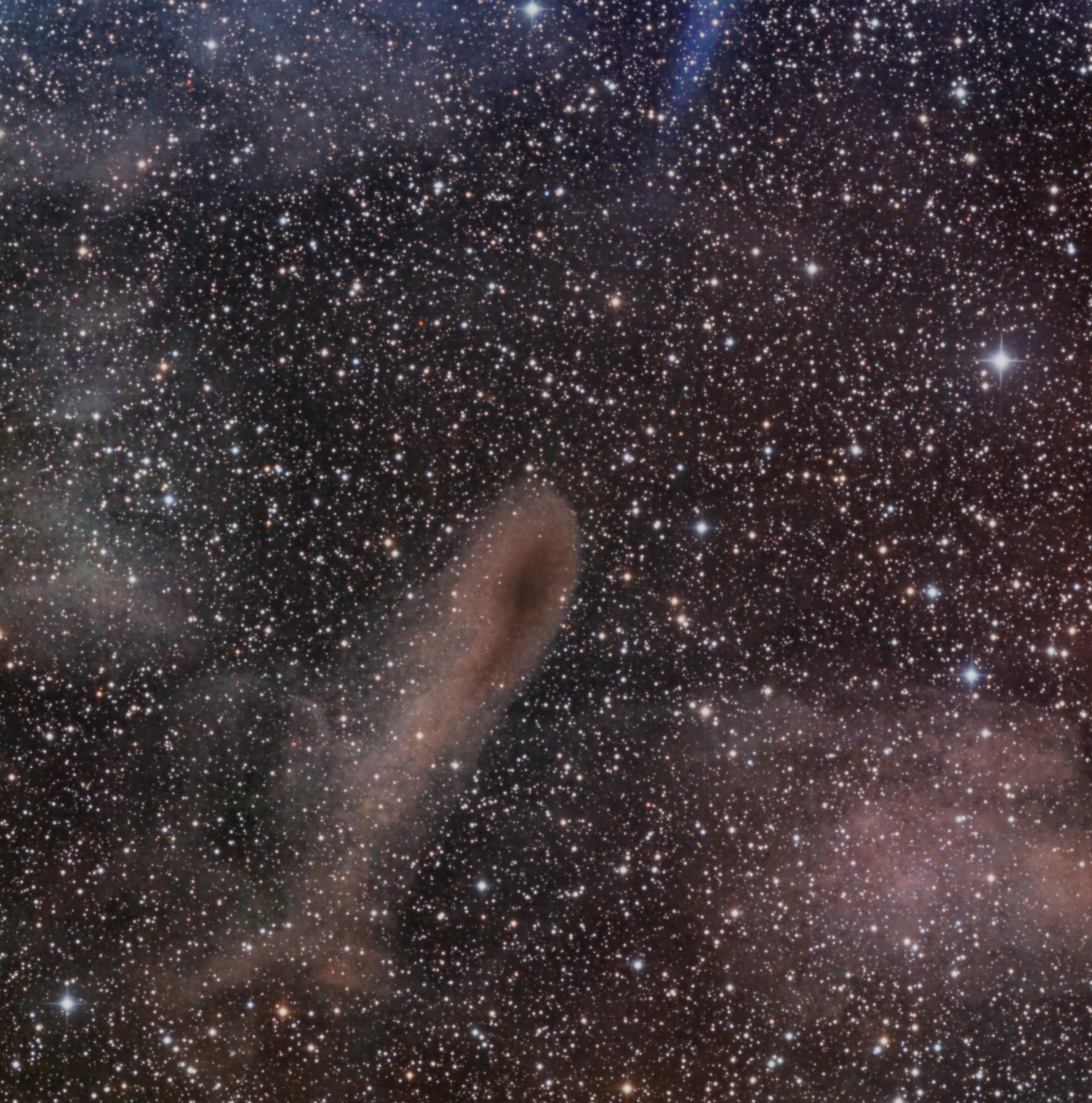 |
| Messier
24 Messier 24 is also known as the Small Sagittarius Star Cloud. It is officially a star field, but there are several other objects that surround the central star field. The object is about 600 light-years wide. there are two distinct dark nebulae. Image processed by Ron Yelton, original data from Telescope Live |
RCW 40
There isn't much information about this object other than it is an emission nebula in the constellation Vela. Image processed by Ron Yelton, original data from Telescope Live |
Sh2-157
- The Lobster
Claw Nebula
This an emission nebula in the constellation Cassiopeia.It lies about 11,000 light-years away from us. The orange-ish area in the center is predominantly Ha. The rest of the nebula is a various areas of OIII and a little SII. Image processed by Ron Yelton, original data from Telescope Live |
|
Location: IC Astronomy Observatory, Spain
Date: June 2024 Mount: Officina Stellare ProRC 700 Telescope:Officina Stellare ProRC 700 (SPA-2) Camera: QHY600m @ -25c Exposure: 38 x 5 min each for HSo Total: 6hrs 10 min |
Location: El
Sauce Observatory, Chile
Date: June 2024 Mount: Mathis MI-1000 Telescope: Planewave CDK24 f/6.6 Camera: QHY600m CMOS @-25c (CHI-1) Exposure: 38 x 5 min each for OHS. Total: 3 hrs 10 min |
Location:
IC Astronomy Observatory, Spain
Date: June 30, 2020 Mount: Paramount MX+ Telescope: Takahashi FSQ-106EDX4 (SPA-3) Camera: FLI PL16083 (CCD) @ -25c Exposure: 90 x 450 sec OHS = 11 hrs 25 min |
 |
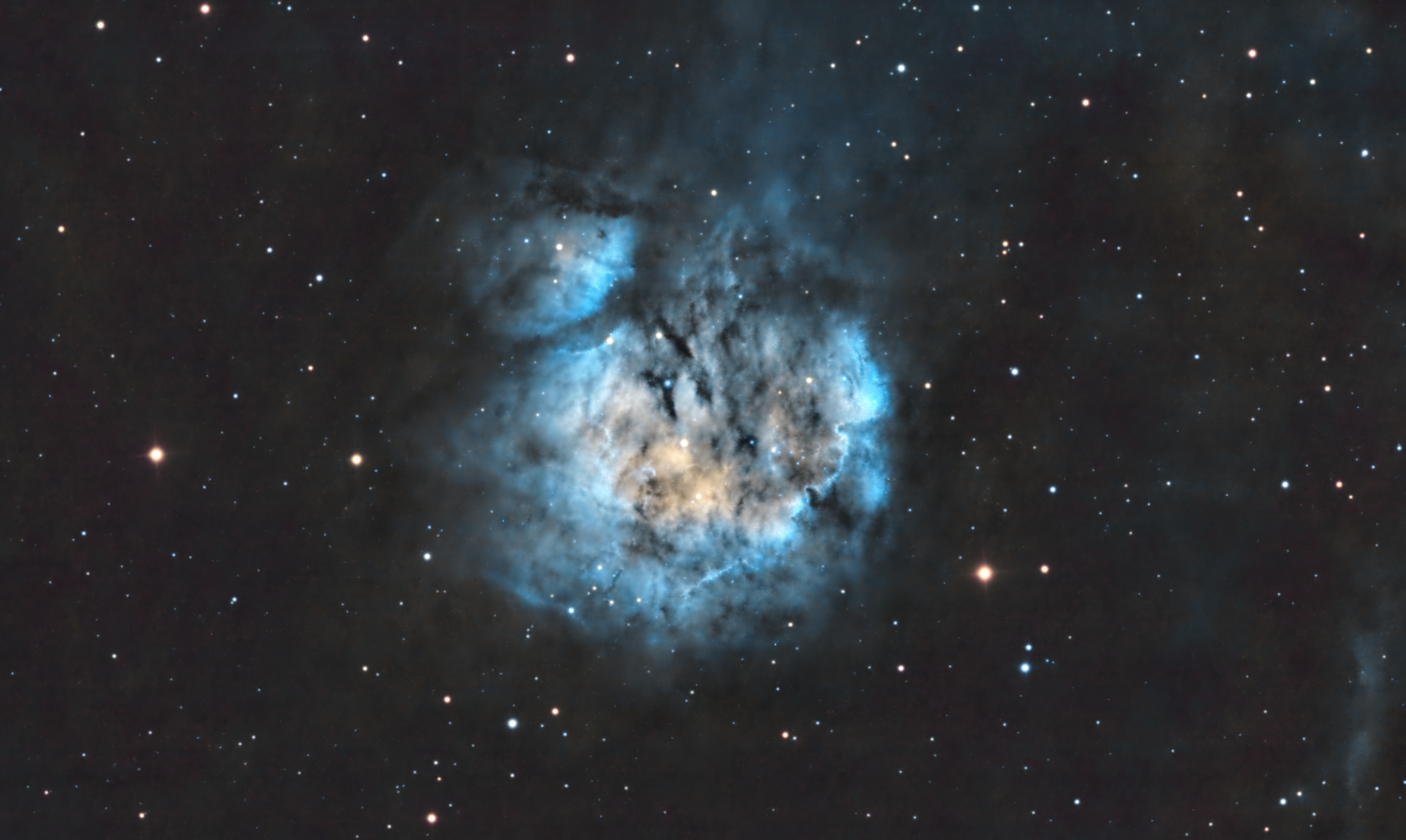 |
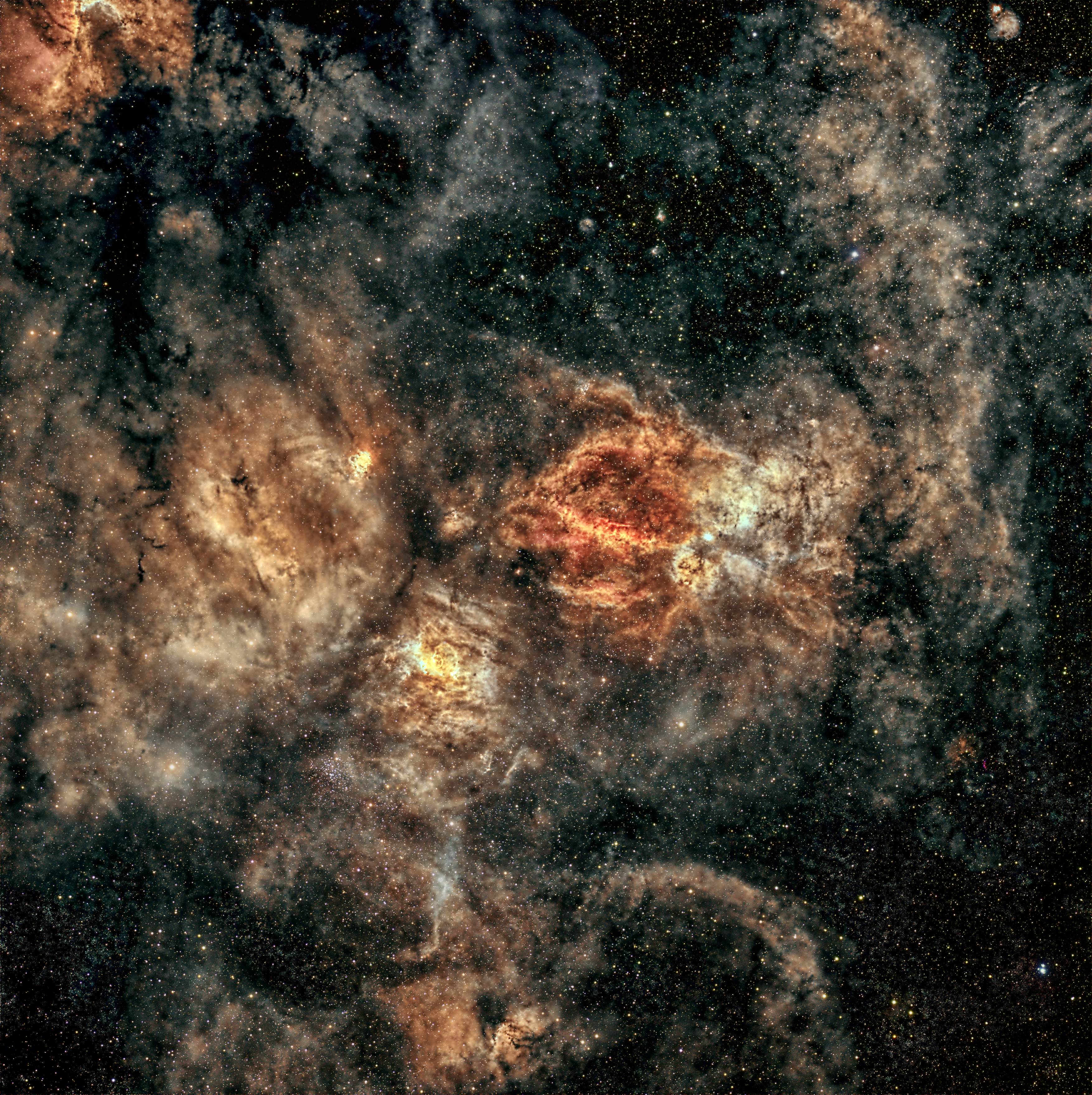 |
| Vela
XYZ Vela XYZ is a supernova remnant located in the southern constellation of Vela. It's the expanding sphere of gas left over from the death throws of a star. It is believed to have exploded around 11,000 years ago, and at 900 light-years away, it is the closest SNR known to us. This image was processed with the HSO palette. Image processed by Ron Yelton, original data from Telescope Live |
RCW 40
Here is another version of the Vela. This one processed with the OHS palette. I think I like this one better that the preceding one. I did two versions to show that by assigning the different filters to the color channels in various combinations, different structural details can be seen. I couldn't find the info again, but last time I checked, I remember that the HST carries at least 52 different filters. Image processed by Ron Yelton, original data from Telescope Live |
NGC
2170 William Herschel discovered this reflection nebula in 1784 in the constellation Monoceros Image processed by Ron Yelton, original data from Telescope Live |
|
Location:
Heaven's Mirror Observatory,
Australia
Date: February - March 2024 Mount: Paramount MX+ Telescope: FSQ-106ED (AUS-2) Camera: QHY600m @ -25c Exposure: 91 x 5 min each for HSO Total: 7hrs 35 min |
Location:
Heaven's Mirror Observatory,
Australia
Date: February - March 2024 Mount: Paramount MX+ Telescope: FSQ-106ED (AUS-2) Camera: QHY600m @ -25c Exposure: 91 x 5 min each for OHS Total: 7hrs 35 min |
Location: El
Sauce Observatory, Chile
Date: March 2024 Mount: Mathis MI-1000 Telescope: Planewave CDK24 f/6.6 Camera: QHY600m CMOS @-25c (CHI-1) Exposure: 111 x 5 min each for LRGB. Total: 8 hrs 45 min |
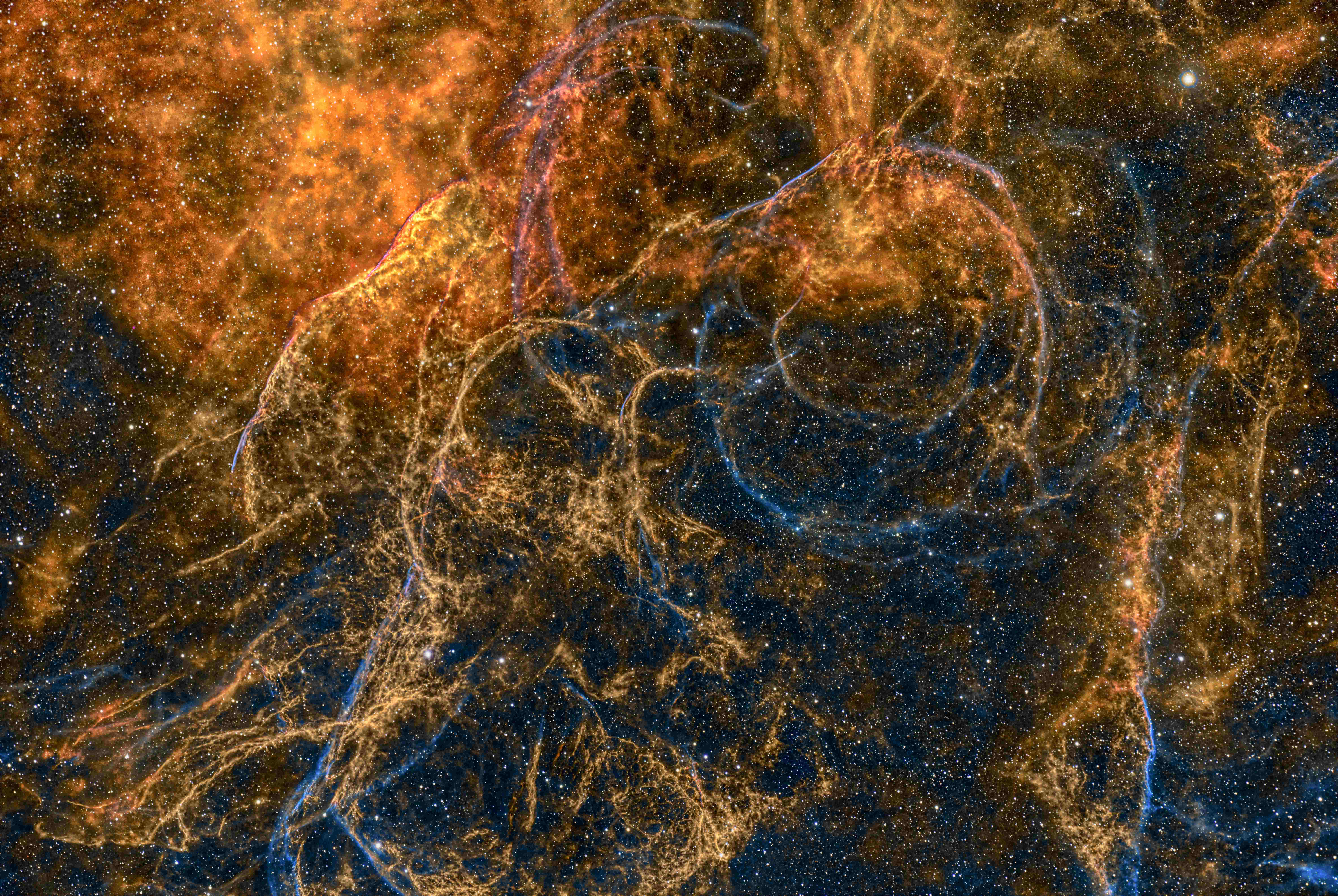 |
 |
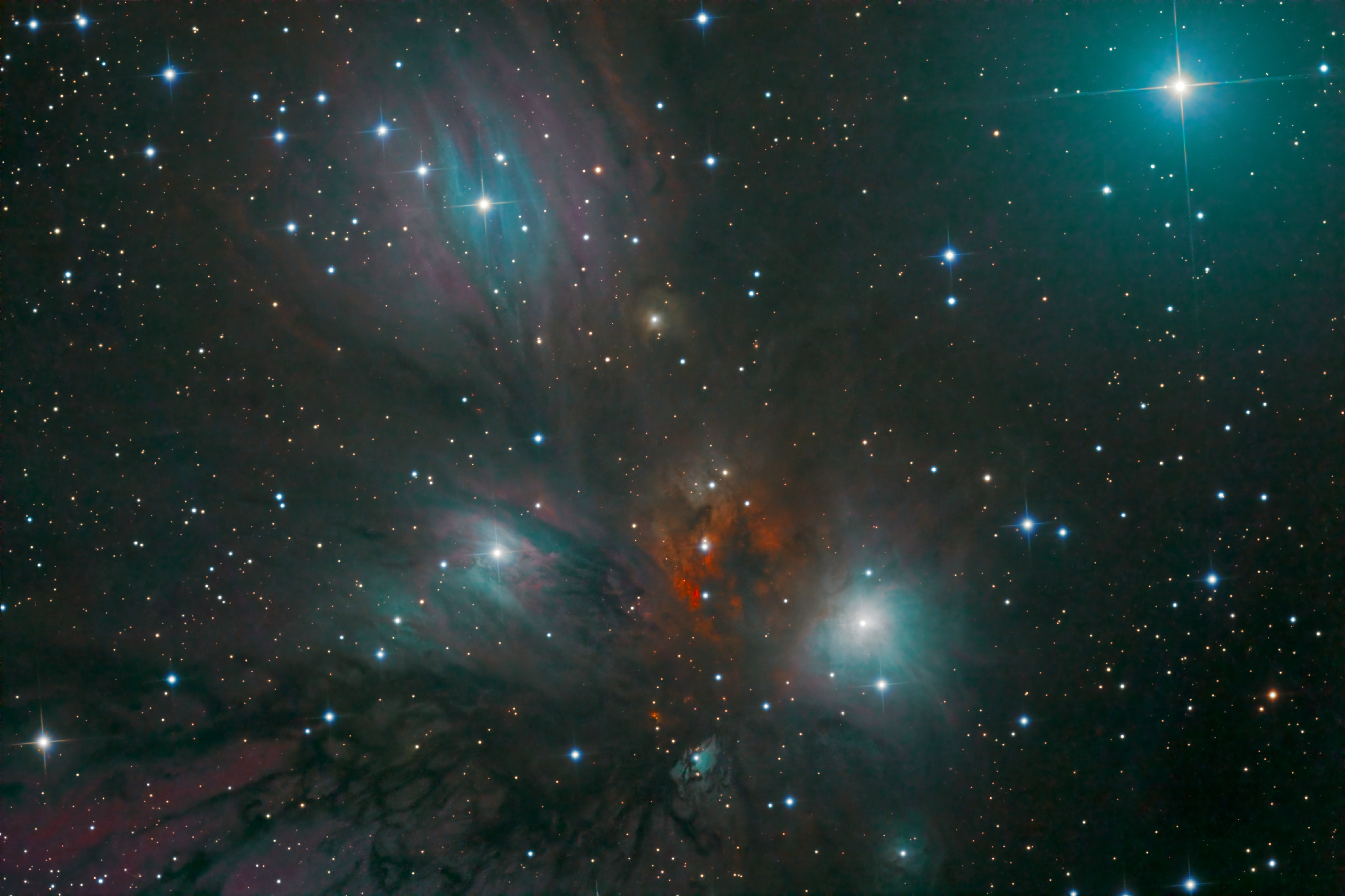 |
| Dark
Wolf or Fenrir Nebula This dark nebula is located in the constellation Scorpius, and is superimposed on the emission nebula RCW 113 This is an LRGB version Image processed by Ron Yelton, original data from Telescope Live |
Dark
Wolf or Fenrir Nebula Here is another version of the Dark Wolf Nebula (to the left). This version was taken with just a Hydrogen Alpha filter (Ha). Image processed by Ron Yelton, original data from Telescope Live |
|
|
Location: El Sauce Observatory, Chile
Date: July 2024 Mount: Mathis MI-1000 Telescope: Planewave CDK24 f/6.6 Camera: QHY600m CMOS @-25c (CHI-1) Exposure: 265 x 5 min each for LRGB. Total: 18 hrs 25 min |
Location:
El Sauce
Observatory, Chile
Date: July 2024 Mount: Mathis MI-1000 Telescope: Planewave CDK24 f/6.6 Camera: QHY600m CMOS @-25c (CHI-1) Exposure: 78 x 5 min each for HA. Total: 6 hrs 30 min |
|
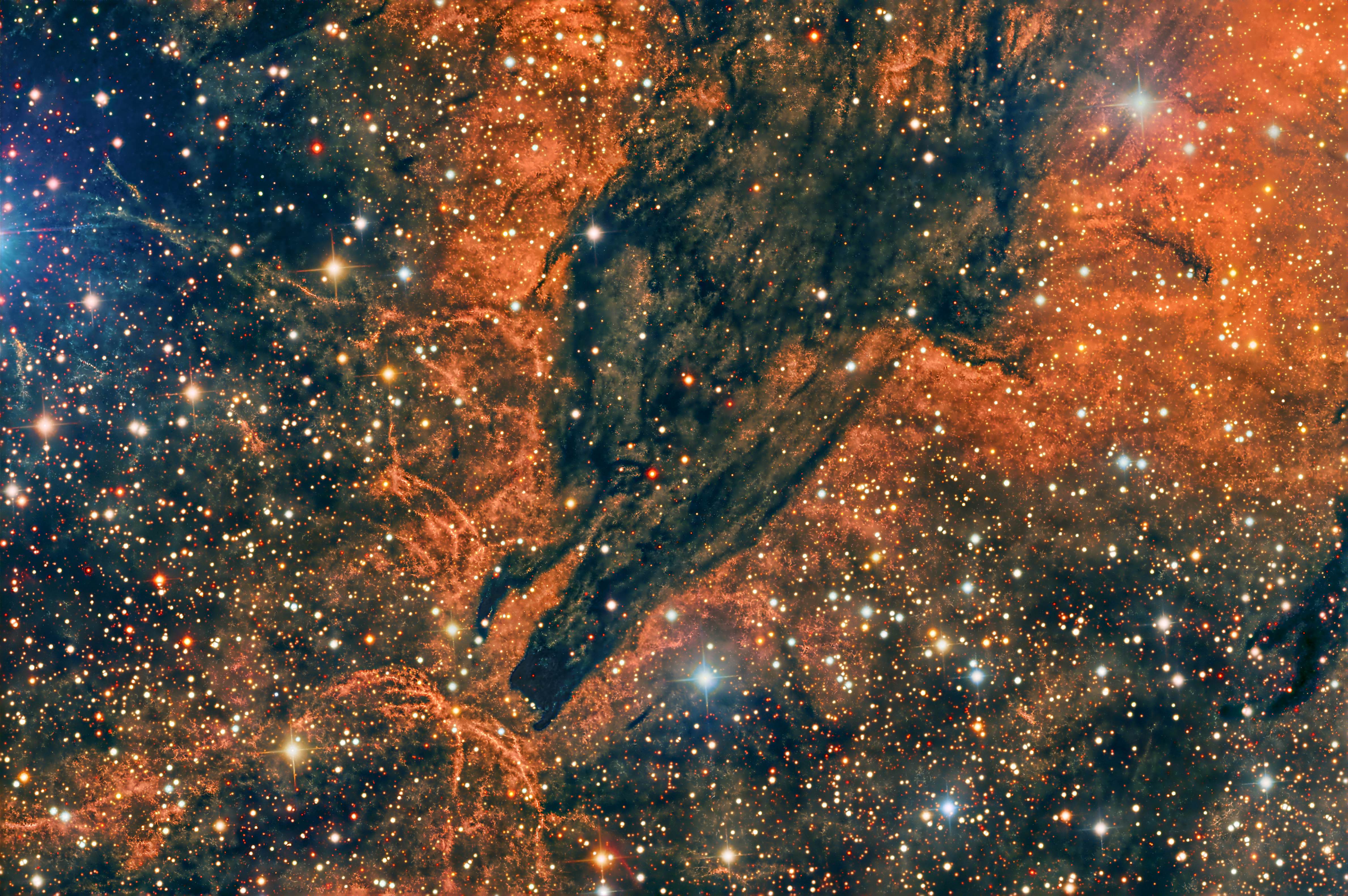 |
 |
Except as noted all images Copyright © by Ron Yelton and may not be used without permission.